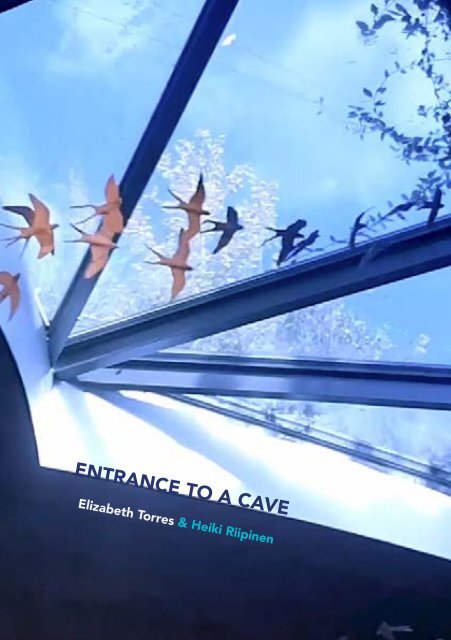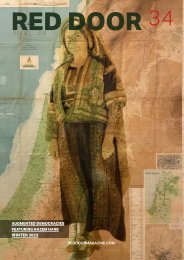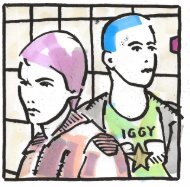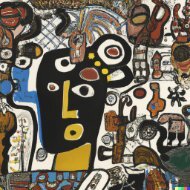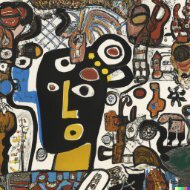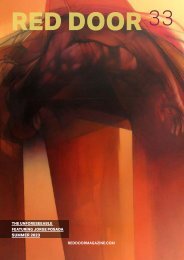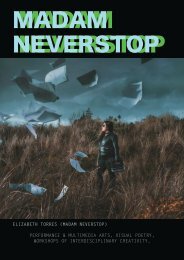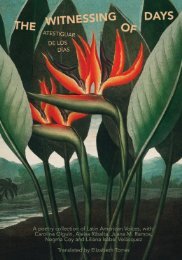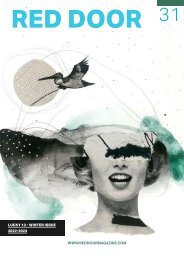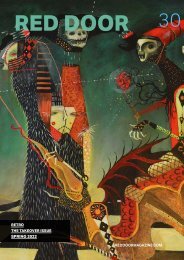You also want an ePaper? Increase the reach of your titles
YUMPU automatically turns print PDFs into web optimized ePapers that Google loves.
<strong>ENTRANCE</strong> <strong>TO</strong> A <strong>CAVE</strong><br />
<strong>Elizabeth</strong> <strong>Torres</strong> & <strong>Heiki</strong> <strong>Riipinen</strong>
<strong>ENTRANCE</strong> <strong>TO</strong> A <strong>CAVE</strong><br />
By <strong>Elizabeth</strong> <strong>Torres</strong> & <strong>Heiki</strong> <strong>Riipinen</strong><br />
Red Press, 2022<br />
ISBN 978-87-94003-11-7<br />
Copenhagen, Denmark<br />
Den Danske Scenekunstskole<br />
MFA in Performing Arts<br />
Performance project done collectively<br />
<strong>by</strong> Simon David Zeller, Clara Sindel,<br />
<strong>Elizabeth</strong> <strong>Torres</strong> <strong>and</strong> <strong>Heiki</strong> <strong>Riipinen</strong><br />
at HC Andersens Hus<br />
Odense, 2022<br />
All poetry, photography, video <strong>and</strong> art<br />
<strong>by</strong> <strong>Elizabeth</strong> <strong>Torres</strong><br />
(Madam Neverstop)
“I’d like to know – do you really deserve to<br />
have someone run to the end of the world just<br />
for your sake?”<br />
- Hans Christian Andersen.
By <strong>Elizabeth</strong> <strong>Torres</strong>, Simon David Zeller,<br />
Clara Sindel, <strong>and</strong> <strong>Heiki</strong> <strong>Riipinen</strong>, 2022.
“This is an intervention. A message from that<br />
space in the margin that is a site of creativity<br />
<strong>and</strong> power, that inclusive space where we<br />
recover ourselves, where we move in solidarity<br />
to erase the category colonized / colonizer.<br />
Marginality as site of resistance. Enter that<br />
space. Let us meet there. Enter that space. We<br />
greet you as liberators.”<br />
-bell hooks, Marginality as site of resistance.
<strong>ENTRANCE</strong> <strong>TO</strong> A <strong>CAVE</strong><br />
On sensual poetics, intimacy, <strong>and</strong> human connection<br />
By <strong>Elizabeth</strong> <strong>Torres</strong><br />
The drawing is called Entrance<br />
to a Cave. It is an illustration<br />
in brown ink. The l<strong>and</strong>scape<br />
is filled with leaves, branches,<br />
large rock formations, a perfect<br />
moment in autumn gone<br />
completely unmemorable, were<br />
it not for the part of the darkest<br />
area of the drawing, which<br />
attracts the attention of the<br />
eye, an invitation to visit that<br />
which is forbidden. It is indeed<br />
an opening, an entrance, <strong>and</strong><br />
after that, darkness, possibility.<br />
Who if not a poet, who if not<br />
H.C Andersen <strong>and</strong> his mind<br />
which always sought out<br />
mystery, would focus on the<br />
dark spaces of such a peaceful<br />
place? The drawing is from<br />
approximately 1845, although it<br />
doesn’t have a specific date in<br />
the book I hold in my h<strong>and</strong>s to<br />
show to my colleagues, while I<br />
read out loud that it is actually<br />
part of the HC Andersens Hus<br />
collection. The book is an entire<br />
treasure on its own, a cherished<br />
item in my collection, for it<br />
is a catalogue publication of<br />
another exhibition, which took<br />
place at the Irish Museum of Art<br />
almost 15 years ago, titled Cut-<br />
Outs <strong>and</strong> Cut-Ups, celebrating<br />
the work of Hans Christian<br />
Andersen <strong>and</strong> William<br />
Burroughs, an admired queer<br />
transgressor, multimedia artist<br />
<strong>and</strong> poet, whose influence<br />
in my work is notable due to<br />
his introduction of the cut-up<br />
method, a technique in which<br />
one collages words <strong>and</strong> pieces<br />
from daily life to turn them into<br />
new connections of text. The<br />
book explains the pairing of<br />
these two creators:<br />
“Both artists were highly<br />
attuned to the close, symbiotic<br />
relationship between the visual<br />
<strong>and</strong> the written. (…) Andersen’s<br />
books contained compilations<br />
of printed imagery, texts <strong>and</strong><br />
drawings, as well as his own<br />
distinctive cut-outs. (…) in the<br />
combination of h<strong>and</strong>made cutouts,<br />
drawings, texts, <strong>and</strong> massproduced<br />
images, Andersen’s<br />
picture books comprised an<br />
early example of modernist<br />
language. He used his scissors<br />
to connect contemporary<br />
events to mythical times cutting<br />
<strong>and</strong> pasting so as to excavate<br />
hidden treasures from quotidian<br />
materials.”
We’re sitting in the museum<br />
brainstorming on ideas to create<br />
work reflecting on the permanent<br />
exhibition at HC Andersens Hus<br />
in Odense, where we have been<br />
asked to create performances<br />
with a non-existent budget<br />
<strong>and</strong> limited time but great<br />
enthusiasm, in hopes of them<br />
commenting on the modern<br />
displays, the audio guides<br />
<strong>and</strong> fluctuating l<strong>and</strong>scapes,<br />
the fancy architecture <strong>and</strong> the<br />
la<strong>by</strong>rinths that celebrate the<br />
mythical <strong>and</strong> the real of HC<br />
Andersen’s story <strong>and</strong> legacy. But<br />
instead, it is something else that<br />
attracts our attention; It is the<br />
collection of letters, the objects<br />
hidden behind “glory holes”,<br />
the dried flowers <strong>and</strong> other<br />
trinkets that the poet namely<br />
collected as souvenirs of his<br />
affairs <strong>and</strong> romantic friendships,<br />
placed in the hallway right<br />
before the fairytale main area<br />
of the museum, where big<br />
letters explain that he was not<br />
very successful in the love <strong>and</strong><br />
romance department. Could<br />
this be because he was queer?<br />
Was it because he wasn’t good<br />
looking? Did he really have<br />
no sexual drive? Is it true that<br />
he wrote down every time he<br />
masturbated? But if queerness<br />
did not exist 200 years ago, (we<br />
well know that even Burroughs<br />
had to go to the supreme court<br />
for his own queer literature a<br />
century later) then who are we<br />
to decide whether or not HC<br />
Andersen was or not successful,<br />
if he was loved, if he knew<br />
of intimacy? …does intimacy<br />
require touch? Is it something<br />
that requires proof?<br />
My colleagues Simon David<br />
Zeller, <strong>Heiki</strong> <strong>Riipinen</strong>, Clara<br />
Sindel <strong>and</strong> I, decided to face the<br />
subject head on, also inspired<br />
<strong>by</strong> our own queerness <strong>and</strong><br />
fluidity, our own underst<strong>and</strong>ing<br />
of sensuality <strong>and</strong> intimacy, as<br />
well as of neurodivergence, <strong>and</strong><br />
moved <strong>by</strong> the invasive feelings<br />
of peeking through the private<br />
life of a stranger, while being<br />
followed around the museum<br />
with an audio guide in our heads<br />
whispering in various voices<br />
maniacally <strong>and</strong> contradicting<br />
itself… which led us all to wish<br />
for an intimate experience that<br />
would persuade people to<br />
disconnect themselves from the<br />
headphones <strong>and</strong> seek secrecy<br />
connection <strong>and</strong> deviance.<br />
Personally, I thought of my own<br />
ideas of intimacy as that which<br />
is corporal <strong>and</strong> mental, physical<br />
<strong>and</strong> spiritual, that which does<br />
not require tangibility. Citing<br />
Azaldua, Robert Gutierrez-<br />
Perez speaks of writing as a<br />
shamanic transformation, a path<br />
between the ethereal <strong>and</strong> the<br />
physical:“The ability of story<br />
(prose <strong>and</strong> poetry) to transform
the storyteller <strong>and</strong> the listener<br />
into something or someone<br />
else is shamanistic”. It is an<br />
aesthetic or an orientation to<br />
the page that does not “split<br />
the artistic from the functional,<br />
the sacred from the secular, art<br />
from everyday life”. Shifting<br />
into an artistic orientation to<br />
the page, performative writing<br />
utilizes “the imagination to<br />
impose order on chaos; she<br />
gives psychic confession<br />
form <strong>and</strong> direction, provides<br />
language to distressed <strong>and</strong><br />
confused people… a language<br />
that expresses previously<br />
inexpressible psychic states <strong>and</strong><br />
enables the reader to undergo<br />
in an ordered <strong>and</strong> intelligible<br />
form real experiences that<br />
would otherwise be chaotic <strong>and</strong><br />
inexpressible.”<br />
Our idea of a transgressive<br />
installation <strong>and</strong> performance<br />
was very limited in its delivery<br />
due to the specifics of the space,<br />
but we insisted on the subject<br />
of a darkroom. We requested<br />
also a velvet tape to seal an<br />
imaginary area’s entrance <strong>and</strong><br />
exit, with uniformed bouncers<br />
who would supervise the access<br />
of an exclusive audience who<br />
would be invited <strong>and</strong> individually<br />
guided to experience something<br />
that would peak their curiosity,<br />
in one-on-one performances. A<br />
sign next to the bouncers, right<br />
in the middle of the fairytale<br />
area, explained what was<br />
happening:<br />
”In seeking to speak of the<br />
sensual poetics <strong>and</strong> intimate<br />
connections threaded within<br />
Andersen’s stories, the<br />
Danske Scenekunstskole MFA<br />
performance artists Simon David<br />
Zeller, Clara Sindel, <strong>Elizabeth</strong><br />
<strong>Torres</strong> an <strong>Heiki</strong> <strong>Riipinen</strong>, invite<br />
you to experience a one-on-one<br />
exclusive performance. (18+)<br />
With your consent <strong>and</strong><br />
imagination, discretion <strong>and</strong><br />
intention let our bouncer guide<br />
you to a surprise you’ll cherish<br />
in secrecy. (1) A dark room<br />
or darkroom – also known as<br />
a backroom, blackroom, or<br />
playroom – is a room, typically<br />
at a nightclub, sex club,<br />
bathhouse, or adult bookstore,<br />
where patrons of the business<br />
can engage in relatively<br />
discreet sexual activity. Dark<br />
rooms usually have little or no<br />
lighting, possibly incorporating<br />
blacklights or dim, colored<br />
lighting to establish an<br />
atmosphere of twilight <strong>and</strong><br />
secrecy. – Wikipedia.”<br />
The Cave was less of a cave <strong>and</strong><br />
more of an elevator entrance<br />
hidden between two curtains,<br />
but we were able to transform<br />
it with red light to use it as our
darkroom, our transgressive,<br />
queer sacred space where desire<br />
<strong>and</strong> sensual poetics run free. In<br />
this case, through a drag queen<br />
reading stories <strong>by</strong> the famous<br />
poet or writing love letters,<br />
or maybe <strong>by</strong> a fortuneteller<br />
reading the tarot to her guests,<br />
or instead <strong>by</strong> a young heart<br />
learning children songs from<br />
strangers, or, in my case, <strong>by</strong> a<br />
poet hungry for new secrets to<br />
write about on a typewriter.<br />
From the collaborative aspect<br />
I learned to push myself<br />
in ways where I step out<br />
of my comfort zone while<br />
simultaneously remaining in a<br />
safe shelter of intimacy, which<br />
is a very contrasting, impactful<br />
experience, <strong>and</strong> which was very<br />
challenging for all of us. It was<br />
also quite delightful to speak of<br />
queering up a museum, pushing<br />
boundaries, testing limits, but<br />
doing all of this with secrecy,<br />
elegance, artfulness, with<br />
respect to the space <strong>and</strong> to the<br />
history, as well as to one another,<br />
forming deep connections with<br />
everyone involved, no matter<br />
how brief these moments of<br />
intimacy <strong>and</strong> connection lasted.<br />
From an individual aspect,<br />
challenging myself to seek the<br />
shamanic psycho confessions<br />
through dreams, fears, desires,<br />
<strong>and</strong> other intimate conversations<br />
with strangers, led to a fast flow<br />
or poetry flux that allowed me to<br />
quickly make new connections<br />
<strong>and</strong> create poetry as an<br />
immediate artistic response <strong>and</strong><br />
performance simultaneously<br />
with a typewriter- poetry objects<br />
which I could then sign, fold<br />
<strong>and</strong> give to a stranger, forming<br />
a moment of confession <strong>and</strong><br />
connection unique to them <strong>and</strong><br />
myself, something I definitely<br />
plan to continue exploring in<br />
the near future.<br />
Bibliography<br />
Cut-Outs <strong>and</strong> Cut-Ups, 2008, Hans<br />
Christian Andersen <strong>and</strong> William<br />
Seward Burroughs, edited <strong>by</strong> Hendel<br />
Teicher, Irish Museum of Modern art.<br />
Greta Gaard, 2018, Identity politics<br />
as comparative politics, Borderwork.<br />
bell hooks, 1989, Feminist<br />
Theory: From Margin to Center /<br />
Marginality as site of resistance.<br />
Robert Gutierrez-Perez (2019):<br />
Theories in the Flesh <strong>and</strong> Flights of<br />
theImagination: Embracing the Soul<br />
<strong>and</strong> Spirit of Critical Performative<br />
Writing in CommunicationResearch,<br />
Women’s Studies in Communication.<br />
Anzaldua, Gloria, 2015, Light in the<br />
Dark/Luz en Lo Oscuro: Rewriting<br />
Identity, Spirituality, Reality, Edited<br />
<strong>by</strong> Ana Louise Keating, Duke UP.
<strong>ENTRANCE</strong> <strong>TO</strong> A <strong>CAVE</strong><br />
A love letter, a critical thought, <strong>and</strong> a loving thought...<br />
By <strong>Heiki</strong> <strong>Riipinen</strong><br />
I. A love letter...<br />
Hi Henrik,<br />
I have to come clean.<br />
I’ve had a secret affair. His name<br />
is Hans Christian.<br />
My dead man of choice has<br />
always been you, Ibsen. We have<br />
had an intimate relationship<br />
going back to childhood. Both<br />
of us come from the same<br />
place in Norway, both of us are<br />
interested in the modern human<br />
<strong>and</strong> we fight societal norms. Yet<br />
Hans has always found his way<br />
back into my life, as my fairytale<br />
Danish lover.<br />
Our first encounter was through<br />
Ariel, the Little Mermaid. But in<br />
a watered down (pun intended)<br />
Disney-version of course. My first<br />
professional meeting with him<br />
was in 2017 when I was asked<br />
to direct a street performance<br />
for the HC Andersen Festival in<br />
Odense. Not really knowing his<br />
work I decided to go fishing for<br />
clues in the city <strong>and</strong> collective<br />
conciseness of its inhabitants.<br />
I walked the streets <strong>and</strong> asked<br />
r<strong>and</strong>om people to retell the<br />
stories, <strong>and</strong> it quickly became<br />
clear that even in his birth town,<br />
a lot was forgotten. The little<br />
pieces I got I gathered in an<br />
absurdist retelling juxtaposed<br />
with an actor interviewing<br />
his gr<strong>and</strong>ma on the power<br />
of memory. I left Hans there,<br />
deeming it a fun time, but not<br />
something to build a serious<br />
relationship on.<br />
The second time we got together<br />
was in 2019. I was working<br />
as a dramaturge-assistant at<br />
Deutsches Theater in Berlin. We<br />
were doing the Ugly Duckling,<br />
or at least that was the title. We<br />
were also doing the mermaid,<br />
<strong>and</strong> goose came <strong>by</strong>, <strong>and</strong> three<br />
Berlin drag queens told their<br />
own stories. Again Hans invited<br />
us to use our own imagination.<br />
This is when I truly got to know<br />
the queer side of Hans. I learned<br />
about his love letters to men,<br />
about how he probably never<br />
had sexual intercourse, but still<br />
through his diaries I knew the<br />
exact dates he masturbated.
I felt we got closer this time,<br />
but again I left him there. I just<br />
wasn’t sure what to do with a<br />
dead wanker.<br />
The third time we again met<br />
in Odense. As part of our<br />
MFA we were asked to make<br />
a performative intervention in<br />
his museum. I walked around<br />
trying to find the Hans I knew,<br />
the queer Hans that invites us to<br />
write on, but all I found was a<br />
single letter in a hallway.<br />
We formed a group <strong>and</strong> decided<br />
to take action, our intervention<br />
would center the queerness of<br />
Hans in his museum, if only for<br />
a moment. In the middle of the<br />
fairytale room, we would create<br />
a realistic contemporary queer<br />
space, a dark room.<br />
A place where I could meet<br />
Hans if he lived today, where we<br />
finally could have our adventure.<br />
...But then the fairytale ended.
II. A critical thought...<br />
Reflecting on collaboration in<br />
this project in particular requires<br />
peeling through layers. The<br />
first layer is the collaboration<br />
between the students <strong>and</strong> the<br />
school. It raises questions of<br />
power dynamics as well as a<br />
bigger narrative; What is the<br />
MFA? Who defines it? And<br />
what role does it play in the<br />
field of theatre? The second<br />
is the collaboration between<br />
the school <strong>and</strong> the museum.<br />
Who initiated the project? Is<br />
it an equal relationship, or is<br />
it an exchange with a giver<br />
<strong>and</strong> receiver? Finally it’s the<br />
collaboration between us<br />
students. The collaboration<br />
between the school <strong>and</strong><br />
students had been wearing<br />
thin at this point, leading the<br />
school to give the students<br />
more choice in when <strong>and</strong> where<br />
to rehearse. Our team was split<br />
between two cities, we didn’t<br />
need choice but recourses<br />
to be able to share time <strong>and</strong><br />
space. So we were left with only<br />
a few days of actually working<br />
together. The inner workings<br />
of the collaboration between<br />
the school <strong>and</strong> the museum<br />
are unknown to me, but it led<br />
our group feeling that we were<br />
met <strong>by</strong> an institution under the<br />
impression that they where the<br />
providers of an opportunity,<br />
while we felt we where providing<br />
them with free art.<br />
So the conditions for our<br />
collaboration were a group<br />
divided in two cities, with a<br />
common feeling of not being<br />
appreciated for our contribution.<br />
Under these conditions we felt<br />
that the only thing we could fill it<br />
with was solos based on already<br />
existing skills. We proposed<br />
a darkroom, <strong>and</strong> asked for<br />
resources to have it built. We<br />
had two weeks. First the school<br />
declined, <strong>and</strong> then the museum.<br />
Two days before the opening we<br />
had nothing.<br />
Still, the darkroom was always<br />
ment to be a container. For me<br />
this meant getting in drag.<br />
We found a corner, hidden<br />
behind some curtains, but<br />
insisted on having our entrance<br />
central. In the middle of the<br />
museum’s biggest space, the<br />
fairytale room. From a simple<br />
red velvet rope we would follow<br />
the audience to our improvised<br />
darkroom. Without a box that<br />
itself could carry meaning,<br />
we formed an explicit text<br />
explaining what usually happens<br />
in a darkroom. And we got a<br />
st<strong>and</strong> for it, mounted to the floor.
III. A loving thought...<br />
As a team we found our ways<br />
of living within a structure that<br />
was not built for us. Just as<br />
queer people do in society. And<br />
even though we met resistance,<br />
or maybe perhaps because<br />
of it, I felt proud of what we<br />
accomplished <strong>and</strong> my own<br />
contribution. I wrote love letters<br />
in the corner. Behind the curtains<br />
I met unexacting guests, <strong>and</strong><br />
together we conversed about<br />
sex <strong>and</strong> language, about gender<br />
<strong>and</strong> body, <strong>and</strong> about love. Me<br />
in drag, them as whoever they<br />
wanted me to imagine them as.<br />
We gave love. And we gained<br />
love. We gave intimacy, <strong>and</strong><br />
gained intimacy. We got people<br />
to take off their headsets,<br />
<strong>and</strong> live in the moment. Most<br />
importantly, we gave them<br />
something to talk about as no<br />
one got the same experience.<br />
And together we learned that<br />
no institution is a fairy tale, but<br />
they can be an entrance - but<br />
you have to carve out your cave.<br />
Oh, yes. Henrik, would you<br />
consider being in a polyamorous<br />
relationship with Hans <strong>and</strong><br />
myself? I might need some<br />
magic to balance the harshness<br />
of reality. It will be challenging<br />
for sure, but I will hold your<br />
h<strong>and</strong>. You see, all of us love the<br />
theatre, <strong>and</strong> as theatre people<br />
we know the art of negotiation<br />
<strong>and</strong> collective responsibility. So<br />
if anyone can do it, it is us.
Photo <strong>by</strong> HC Andersens Hus
<strong>ENTRANCE</strong> <strong>TO</strong> A <strong>CAVE</strong><br />
POETRY IN FLUX<br />
<strong>by</strong> <strong>Elizabeth</strong> <strong>Torres</strong>
Written as part of<br />
the collective performance<br />
with the same name<br />
for the daring audience who shared their<br />
dreams, desires <strong>and</strong> fears<br />
with me.
I<br />
Once there was a cave<br />
that looked more like an insatiable mouth<br />
ready to devour everyone’s darkest fantasies<br />
their kinks <strong>and</strong> passions<br />
their burning secrets<br />
<strong>and</strong> that image<br />
in the corner of their mind<br />
they would never dare let out<br />
for a walk.<br />
So they built a museum around it<br />
to hide it <strong>and</strong> keep it closely guarded<br />
<strong>and</strong> around it they built a la<strong>by</strong>rinth<br />
with objects of unrequitted love<br />
stories of unhappy lovers<br />
trinkets of broken hearts<br />
<strong>and</strong> poems so sad<br />
they don’t dare to look up<br />
anymore.<br />
But all the cave<br />
really wanted<br />
was some intimacy<br />
a reason to come out of hiding<br />
from the world of monotony <strong>and</strong> repetition<br />
into the fairytale garden<br />
it could see from the corner<br />
of its eye.<br />
-Let me come out to playit<br />
pleaded in their dreams.<br />
But if it comes out<br />
what will the museum walls say<br />
what, about secrecy <strong>and</strong> morality<br />
what, about queerness <strong>and</strong> love?<br />
...And how will we explain it in our catalogue?<br />
What will the others saaaaay???
II<br />
Once there was a dream<br />
so slippery<br />
so liquid<br />
it kept sliding from bed to bed<br />
through the nights<br />
unable to be remembered.<br />
The secret, said the star<br />
reflected on the lake<br />
at the edge of the cave<br />
is not to attempt to reach<br />
immortality...<br />
But to shine<br />
laugh<br />
exist<br />
hurt<br />
burn<br />
feel<br />
give<br />
shoot<br />
come<br />
let go<br />
allow it in<br />
become<br />
in full intensity.
III<br />
Once upon a time<br />
deep in the jungle<br />
the rain fell so strongly it sounded<br />
like an orchestra of hearts<br />
running in multitudes in search of love<br />
crashing, falling, breaking<br />
never knowing<br />
the secret location of the poetic moment<br />
within<br />
that produces love.<br />
I do not know these secrets either<br />
but I like to dance barefoot in the rain forest<br />
listening to the songs<br />
my own heart whispers.
IV<br />
Once there was a rock<br />
so afraid of the world around her<br />
so absorbed in that inner itch of waiting<br />
that all she could do was dream<br />
of throwing herself into people’s skulls.<br />
When I entered,<br />
I picked her up<br />
<strong>and</strong> hid her under a river<br />
where nobody else would hurt her.<br />
Go to this river<br />
whenever the world seems hostile.<br />
We are all equally petrified,<br />
but love reigns.
V<br />
Once upon a time<br />
in a museum that celebrated the work<br />
of a mysterious poet<br />
a woman found a secret entrance<br />
to a cave<br />
where mystical beings created new dreams<br />
for all<br />
who dared<br />
to be curious.<br />
She wanted a poem of wildflowers,<br />
mostly white,<br />
for her gr<strong>and</strong>daughter<br />
<strong>and</strong> kind animals<br />
<strong>and</strong> happy endings<br />
to accompany her in her life.<br />
So now she has this spell…<br />
a poem<br />
of good fortune, love,<br />
<strong>and</strong> always<br />
magic.
VI<br />
There is a sea<br />
of people<br />
in this path we call life.<br />
Everyone is running<br />
but no one remembers why.<br />
Sometimes people run away<br />
from their troubles,<br />
their past,<br />
their nightmares…<br />
And other times<br />
they run towards fake mirrors <strong>and</strong> gold.<br />
But there are some<br />
who run in search of happiness<br />
with tears in their eyes<br />
because they’re the ones who’ve truly heard<br />
the call of life.
VII<br />
We think we came to this cave<br />
to speak of big cities<br />
with tall buildings <strong>and</strong> multitudes of people<br />
running underground<br />
eating one-dollar pizzas<br />
attending crowded concerts<br />
looking for jobs or love<br />
or for something fun to do<br />
over the weekend.<br />
But no<br />
the big city<br />
holds greater secrets:<br />
People, who like wildflowers<br />
bloom in silence<br />
looking for a connection to the universe<br />
a dream to keep them going.<br />
This is a poem about the city<br />
that never sleeps<br />
written for the one whose dreams<br />
are of <strong>and</strong> for this city.
VIII<br />
You know?<br />
They say dreams<br />
are not just visions<br />
but vessels<br />
so we can remember what it takes to be free,<br />
to be alive,<br />
to let the magic in…<br />
the things poets talk about.<br />
In my dream,<br />
I often visit a great body of water<br />
called the Gr<strong>and</strong> Rapid of the Americas<br />
it takes me precisely<br />
wherever I want to go in the world.<br />
Today, for example,<br />
on this vessel of togetherness,<br />
This cave of intimacy <strong>and</strong> tenderness<br />
we are in,<br />
I too can see<br />
the sun reflecting on the calm water<br />
the great black rocks reaching to the cosmos<br />
<strong>and</strong> you <strong>and</strong> your family<br />
swimming joyfully<br />
while I observe<br />
from the peacefulness of a rock<br />
with this typewriter.
IX<br />
A dream within a dream<br />
is not a mind’s illusion<br />
but an opening<br />
between realms.<br />
Matters of the heart<br />
are not to be explained scientifically<br />
nor studied with sterile lenses<br />
but shared in twilight’s intimacy<br />
piercing letters that evaporate<br />
when we open our eyes<br />
still with the sensation of love<br />
on our tongue.<br />
Turn me into blue<br />
say the lyrics of a song repeating in your head<br />
the coded palpitations of this dream<br />
breathing <strong>and</strong> dancing magic<br />
into our daily world.
X<br />
Once I had a dream<br />
of fresh flowers <strong>and</strong> wild animals<br />
who frolicked at the entrance of a cave<br />
right <strong>by</strong> the water fountain.<br />
Within the cave there is an altar,<br />
with small crystals filled with dew water<br />
everyone who drinks from it has an answer<br />
directly sent to their heart.<br />
Expectation <strong>and</strong> desire are liquid too<br />
they take many shapes <strong>and</strong> as much space<br />
as we allow them to.<br />
Enter this dream, this cave,<br />
whenever you are uncertain<br />
<strong>and</strong> drink from your heart’s own wisdom n<br />
for there is no wrong choice<br />
when you seek with love.
XI<br />
I heard of a place in a tall mountain<br />
where dreams have taken the forms of people<br />
they build houses <strong>and</strong> bridges<br />
plant gardens<br />
<strong>and</strong> at night tell stories of their visions<br />
but their favorite part of the day<br />
is talking about us<br />
how we change through time<br />
<strong>and</strong> pass on our stories<br />
to our children<br />
<strong>and</strong> them to their children<br />
in an eternal cycle<br />
of love <strong>and</strong> wisdom.<br />
This, they say<br />
is how dreams are kept alive.
XII<br />
Just like wines<br />
There are all kinds of people<br />
emotions <strong>and</strong> experiences<br />
places <strong>and</strong> memories<br />
to come in <strong>and</strong> out of.<br />
I heard there is a cave<br />
at the entrance of a dream<br />
where wine tastes<br />
like fresh caresses on spring days.<br />
909 is the label on the bottle<br />
<strong>and</strong> everyone who drinks from it<br />
comes out with eyes filled<br />
with new desire.
XIII<br />
There are parts of ourselves<br />
waiting in the depth<br />
of our garden, to bloom<br />
to devour<br />
to shift shapes<br />
take <strong>and</strong> give of us<br />
what is needed.<br />
Each morning, the door opens<br />
<strong>and</strong> is it up to us to seek<br />
which petal will heal<br />
our longing.
XIV<br />
You thought<br />
this poem was going to be<br />
about a cave<br />
or a dream<br />
about a fountain<br />
or some sort of fairytale<br />
reminiscent of a poem<br />
worthy of a place<br />
such as this…<br />
But no,<br />
the poet<br />
is unable to write<br />
about such things today.<br />
All these keys<br />
want to write about<br />
are your h<strong>and</strong>s<br />
how kindly<br />
they moistened the entrance<br />
of the cave<br />
how delicately<br />
they removed your clothes<br />
when you entered<br />
how elegantly<br />
they applied the lipstick<br />
to your mouth<br />
before you dared to speak<br />
<strong>and</strong> how now<br />
precisely now<br />
in perfect balance, now<br />
they rest upon the pink fur of the cave<br />
to pet it<br />
with the same kind movements<br />
one tames love.
XV<br />
One day<br />
the hummingbird began its daily ritual<br />
but quickly found out<br />
with panicky flutter<br />
that all the flowers<br />
had lost its petals<br />
<strong>and</strong> perished<br />
all around the garden of paradise<br />
even at the entrance<br />
of the cave<br />
where it then laid, in silence<br />
until its heart, too, withered.<br />
Now in the cave<br />
in the place where the hummingbird’s bones<br />
became one with the stones<br />
there is a fountain<br />
of turquoise light <strong>and</strong> bright crystals<br />
where dreams come to drink<br />
to renew their belief.<br />
It isn’t out of love<br />
the world keeps spinning, darling...<br />
it’s out of memory<br />
longing<br />
<strong>and</strong> unfulfilled desire.
www.delegationforthefuture.com


